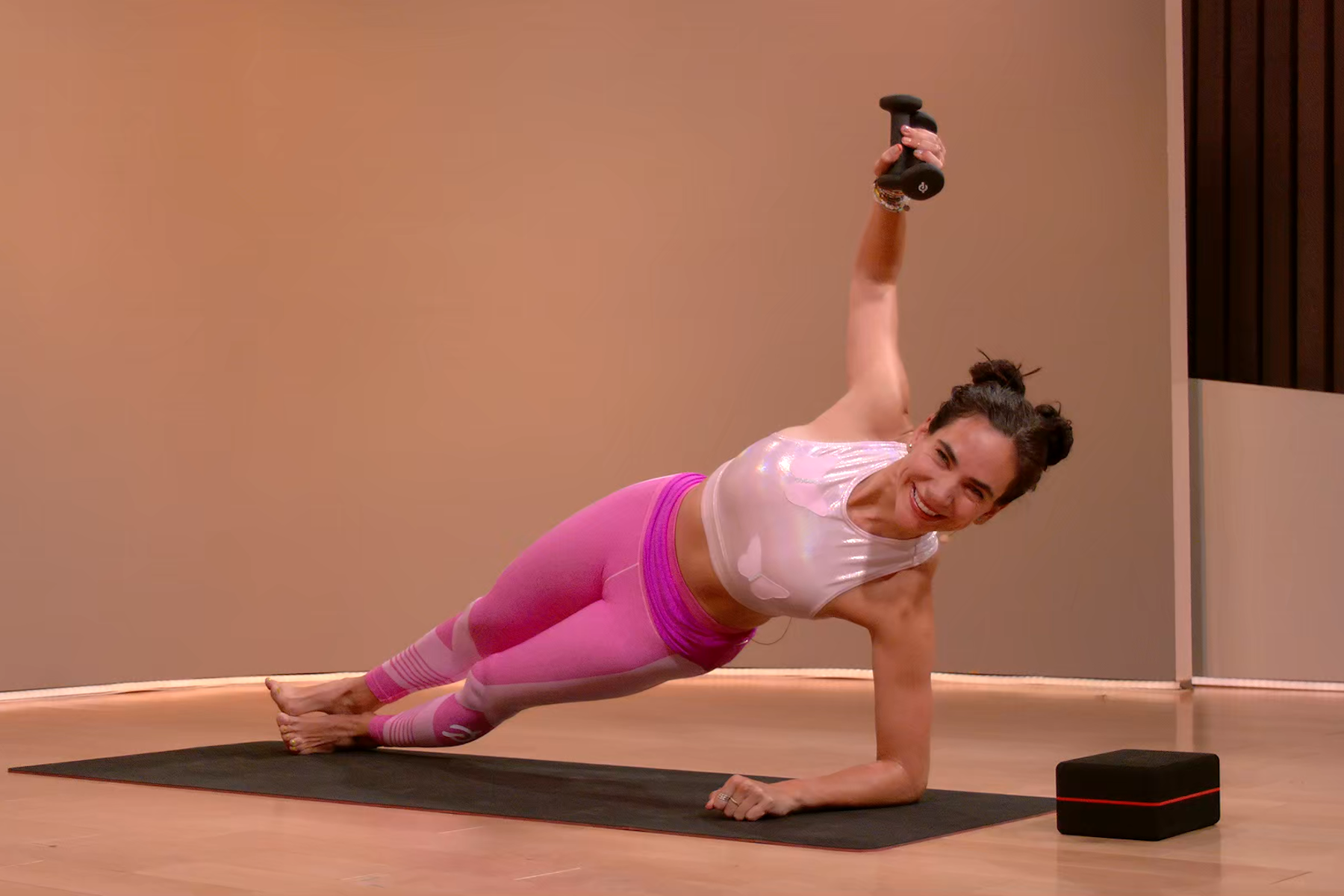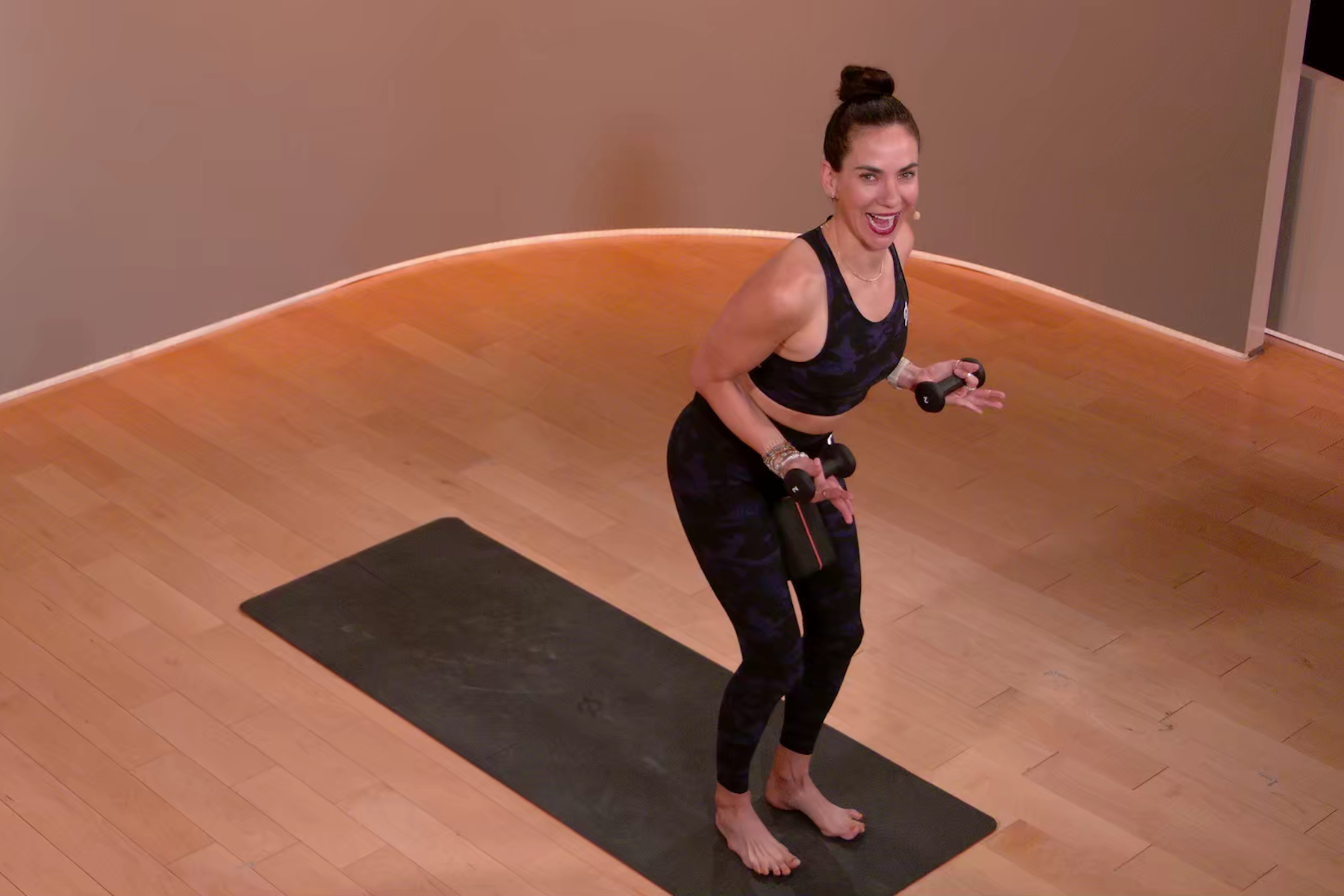
Want to Spice Up Your Yoga? Just Add Weights.
Yoga Conditioning classes incorporate light weights to build strength for yoga postures.
By Michele Ross•
What Is Yoga Conditioning?
What are the Benefits of Yoga with Weights?
What Size Weights Should You Use for Yoga Conditioning?
Our Favorite Yoga Conditioning Poses
Who Should Try a Yoga Class with Weights?
If you’re anything like me, you might be a creature of habit and prefer to stick to a single fitness modality. For years, I pretty much exclusively practiced yoga, leaving the likes of weight training and running by the wayside. As beneficial as yoga is for your mind and body alike, I’m well aware of the merits of a well-rounded workout routine—and I’ve since taken greater care to switch up my sweat sessions.
Discover more ways to reach your goals with Peloton
If you, too, gravitate towards yoga but are looking to diversify your routine, I have a feeling you’ll love Yoga Conditioning, or yoga with weights. Keep reading to see what Peloton’s newest yoga collection is all about and how to use weights in your yoga routine.
What Is Yoga Conditioning?
You can think of Yoga Conditioning as a happy marriage between yoga and strength training. (And, depending on the class you take, perhaps a dash of cardio for good measure.) “Yoga Conditioning is a fun new class that just launched on the Peloton App,” shares Peloton yoga instructor Kirra Michel. “You’ll come across a lot of your favorite and familiar yoga shapes in this class, then we add weights and repetition. Whoever is teaching the class—myself, Kristen McGee, or Mariana Fernández—will explain how it relates to your yoga practice along the way.”
What are the Benefits of Yoga with Weights?

Yoga and resistance training are wonderful options on their own to move and strengthen your body. Together, they’re a multitasking force to be reckoned with. (Plus, it’s pure fun!) Here are a few reasons why they create a perfect pairing.
It Helps Build Strength for Yoga Postures
Countless elements comprise a yoga practice—including but not limited to focus, balance, stamina, and strength. Yoga Conditioning classes not only incorporate free weights to strengthen your arms for the likes of planks, downward dogs, and arm balances, but also other props—like blocks and sliders—to target specific areas of the body and activate other muscles to enhance your yoga practice. “We might also get into some strength exercises that help us get strong and stable, making your favorite yoga poses more accessible,” Kirra adds.
“There are some areas of the body—think arms, core, glutes, and hamstrings specifically—that sometimes get overlooked in a yoga class,” she continues. “Or it may be assumed that the practitioner already has the strength to perform [certain] postures,” citing chaturanga and inversions as examples. By incorporating strength-focused elements into these classes, you’ll be able to hold and/or flow through many poses with more power and greater ease.
It Diversifies Your Fitness Routine
As the saying goes, variety is the spice of life… yet it’s also a crucial element for physical fitness. People who only gravitate towards, say, yin yoga might lack adequate cardio and muscle toning. Similarly, those who prioritize weight lifting or bodyweight exercises could be missing out on the mobility benefits that yoga offers. Doing yoga with weights through a class like Yoga Conditioning essentially checks off all of these boxes in one fun, upbeat, and challenging offering.
“It’s designed to be a workout and possibly get you sweating,” says Kirra. Moreover, it can help you meet physical activity guidelines set forth by the Centers for Disease Control (CDC) and American College of Sports Medicine (ACSM). Both organizations recommend that adults get at least:
30 minutes of moderate-intensity aerobic activity five days per week, or 20 minutes of vigorous-intensity aerobic activity three days per week
strength and/or endurance workouts twice per week
It Adds External Resistance Training to Your Yoga Practice
Anyone who’s completed a chaturanga-packed yoga class knows that you can get seriously strong—and sore—from a vinyasa flow with resistance from your own body weight. Perhaps you’ve even done 108 sun salutations to usher in a new season, or enrolled in an inversion workshop that activated your muscles in ways you never thought possible.
However, external resistance with props incorporates new ways to challenge yourself, engage your muscles, and mix things up. In other words, Yoga Conditioning introduces novelty to keep your body guessing by building upon the foundations of certain poses or flows to level up your practice.
Better yet, these new elements can even promote a higher level of physical activity, consistency, and enjoyment. One 2020 study published in Frontiers in Psychology found that a challenging variation of familiar exercises—which yoga with weights provides—can enhance flow state (i.e., a high level of absorption, motivation, and sense of reward during an activity).
What Size Weights Should You Use for Yoga Conditioning?
Although you may very well be able to lift heavier weights, it’s best to leave your stronger sets for another workout. As Peloton yoga instructor Mariana Fernández explains, the goal for using weights during Yoga Conditioning isn’t to max out strength, but rather to create greater muscle engagement. “A lot of times you think heavier is better, but given the longer holds or amount of reps, the muscles can fatigue too soon, which will lead to misalignment,” she warns.
With that in mind, Mariana advocates for a slow and steady approach when weights are cued in these classes. “I recommend starting super light with one- or two-pound weights,” she shares. (You may also find that you need to build up strength before reaching for weights at all. In this case, she advises creating a fist to mimic holding a weight until you’re ready for the real deal.)
Once you make it through a few classes, you may wish to increase the weight by one pound from there. Taking things one step at a time is “the best way to gauge your strength and improvements as you hold the poses,” Mariana explains.
Our Favorite Yoga Conditioning Poses
If you’ve yet to check out a Yoga Conditioning class on the Peloton App, you might be wondering how props are included alongside your favorite poses or flows. Here are a few examples to satisfy your curiosity—and hopefully inspire you to press play on your first session.
1. High Lunge with Weights
“One of my favorite poses to do with small hand weights is a high lunge with arms extended up,” says Mariana. She mentions that, without weights, you might not fully engage your arms in certain poses because you’re mostly aware of your legs holding you up. (Think high lunges and warriors I and II, for instance. Check out warrior II, below.) “Holding the weights requires you to really activate the arms, starting with the shoulder rotation. And by having the weights, you make sure that the whole length of the arm works together to keep those weights up,” she explains. “You feel the energy move all the way from the shoulder to the fingers keeping the weights in your hands.”

2. Warrior III with Weights
Another Yoga Conditioning pose that Mariana enjoys is warrior III—in which you balance on one leg as the opposite leg floats behind you—while holding weights. “The weights at the center of the chest help stabilize you in the pose,” she shares. “Once you find yourself balanced, you can reach the arms out in front of you, creating a capital letter ‘T’ with your body, which will work the shoulders and arms.” Another variation would be to reach the arms behind you like an airplane along the sides of your body with your palms facing up, which Mariana says will strengthen your back and triceps. “There's so much activation in a singular pose depending on the variation you want to do,” she says.
3. Chair Pose with a Block and Weights

Lastly, Mariana loves this super strengthening pose for Yoga Conditioning. “I place the block between my thighs for chair pose to serve as a reminder to activate the muscles,” she explains. “In order not to drop it, your adductors are fired up, your glutes are working, and you make sure that the whole legs are engaged.” You can do this with arms overhead, no weights, or hold a set of weights with elbows bent to 90 degrees, palms facing up.
She also recommends holding the block between your thighs in plank pose, which “will activate the lower abdominals as well as the full legs,” as well as prevent you from front-loading your weight into your hands and wrists. “Once you feel your whole body working together to not just hold the block, but hold the pose, you will feel a full body strengthening,” Mariana adds.
Who Should Try a Yoga Class with Weights?
Again, doing yoga with weights is ideal for people seeking to diversify their routines from yoga or strength training alone. Yoga Conditioning is also a solid choice if you want to kill two birds (or even three, with higher-intensity classes that offer a cardio boost) with one stone. At least some familiarity with yoga will likely make the class easier to navigate so you can perform the moves safely and without sacrificing form.
“Peloton’s Yoga Conditioning classes help our members build the strength and stability they need to feel more confident in their yoga practice and life,” Kirra concludes. She also notes that these classes are designed to complement, rather than replace, your standard yoga practice.

Peloton App
Access thousands of classes with no equipment needed.
This content is for informational and educational purposes only and does not constitute individualized advice. It is not intended to replace professional medical evaluation, diagnosis, or treatment. Seek the advice of your physician for questions you may have regarding your health or a medical condition. If you are having a medical emergency, call your physician or 911 immediately.
Level up your inbox.
Subscribe for a weekly dose of fitness, plus the latest promos, launches, and events.
By providing your email address, you agree to receive marketing communications from Peloton.
For more about how we use your information, see our Privacy Policy.





